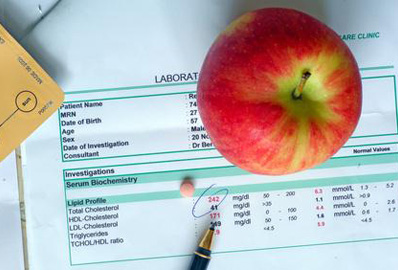
Total Cholesterol
Less than 200 mg/dL: Desirable
If your LDL, HDL and triglyceride levels are also at desirable levels and you have no other risk factors for heart disease, total blood cholesterol below 200 mg/dL puts you at relatively low risk of coronary heart disease. Even with a low risk, however, it’s still smart to eat a heart-healthy diet, get regular physical activity and avoid tobacco smoke. Have your cholesterol levels checked every five years or as your doctor recommends.
200-239 mg/dL: Borderline-High Risk
If your total cholesterol falls between 200 and 239 mg/dL, your doctor will evaluate your levels of LDL (bad) cholesterol, HDL (good) cholesterol and triglycerides. It’s possible to have borderline-high total cholesterol numbers with normal levels of LDL (bad) cholesterol balanced by high HDL (good) cholesterol. Work with your doctor to create a prevention and treatment plan that’s right for you. Make lifestyle changes, including eating a heart-healthy diet, getting regular physical activity and avoiding tobacco smoke. Depending on your LDL (bad) cholesterol levels and your other risk factors, you may also need medication. Ask your doctor how often you should have your cholesterol rechecked.
240 mg/dL and over: High Risk
People who have a total cholesterol level of 240 mg/dL or more typically have twice the risk of coronary heart disease as people whose cholesterol level is desirable (200 mg/dL). If your test didn’t show your LDL cholesterol, HDL cholesterol and triglycerides, your doctor should order a fasting profile. Work with your doctor to create a prevention and treatment plan that’s right for you. Whether or not you need cholesterol-regulating medication, make lifestyle changes, including eating a heart-healthy diet, getting regular physical activity and avoiding tobacco smoke.
Triglycerides
Triglyceride is a form of fat. People with high triglycerides often have a high total cholesterol level, including high LDL (bad) cholesterol and low HDL (good) cholesterol levels.
Many people have high triglyceride levels due to being overweight/obese, physical inactivity, cigarette smoking, excess alcohol consumption and/or a diet very high in carbohydrates (60 percent of more of calories). High triglycerides are a lifestyle-related risk factor; however, underlying diseases or genetic disorders can be the cause.
The main therapy to reduce triglyceride levels is to change your lifestyle. This means control your weight, eat a heart-healthy diet, get regular physical activity, avoid tobacco smoke, limit alcohol to one drink per day for women or two drinks per day for men and limit beverages and foods with added sugars. Visit your healthcare provider to create an action plan that will incorporate all these lifestyle changes. Sometimes, medication is needed in addition to a healthy diet and lifestyle.
HDL Cholesterol
With HDL (good) cholesterol, higher levels are better. Low HDL cholesterol (less than 40 mg/dL for men, less than 50 mg/dL for women) puts you at higher risk for heart disease. In the average man, HDL cholesterol levels range from 40 to 50 mg/dL. In the average woman, they range from 50 to 60 mg/dL. An HDL cholesterol of 60 mg/dL or higher gives some protection against heart disease.
Smoking, being overweight and being sedentary can all result in lower HDL cholesterol. To raise your HDL level, avoid tobacco smoke, maintain a healthy weight and get at least 30-60 minutes of physical activity more days than not.
LDL Cholesterol
The lower your LDL cholesterol, the lower your risk of heart attack and stroke. In fact, it’s a better gauge of risk than total blood cholesterol. In general, LDL levels fall into these categories:
Less than 100 mg/dL – Optimal
100 – 129 mg/dL – Near Optimal
130 – 159 mg/dL – Boderline High
160 – 189 mg/dL – High
190 mg/dL and above – Very High
Source: American Heart Association







